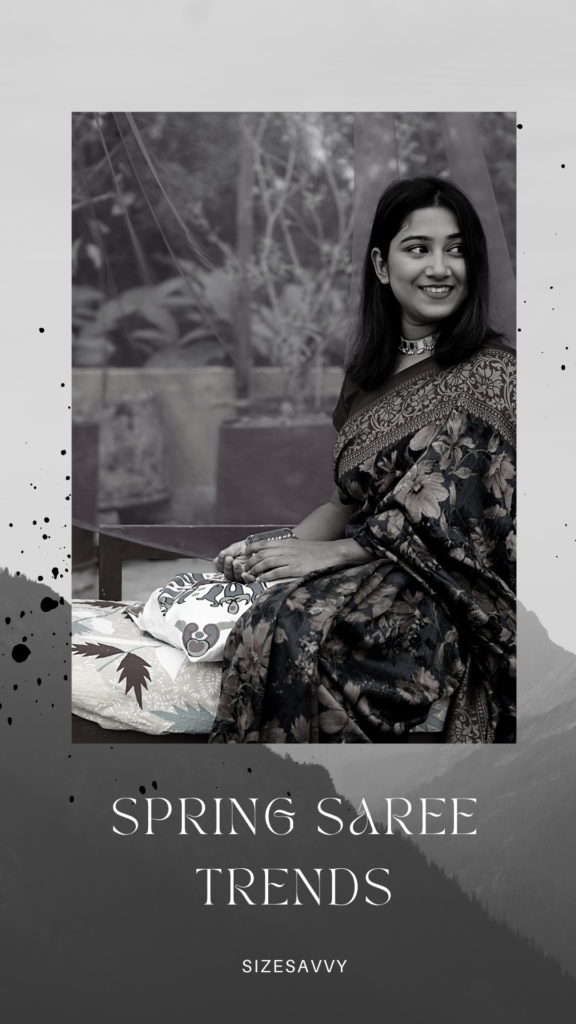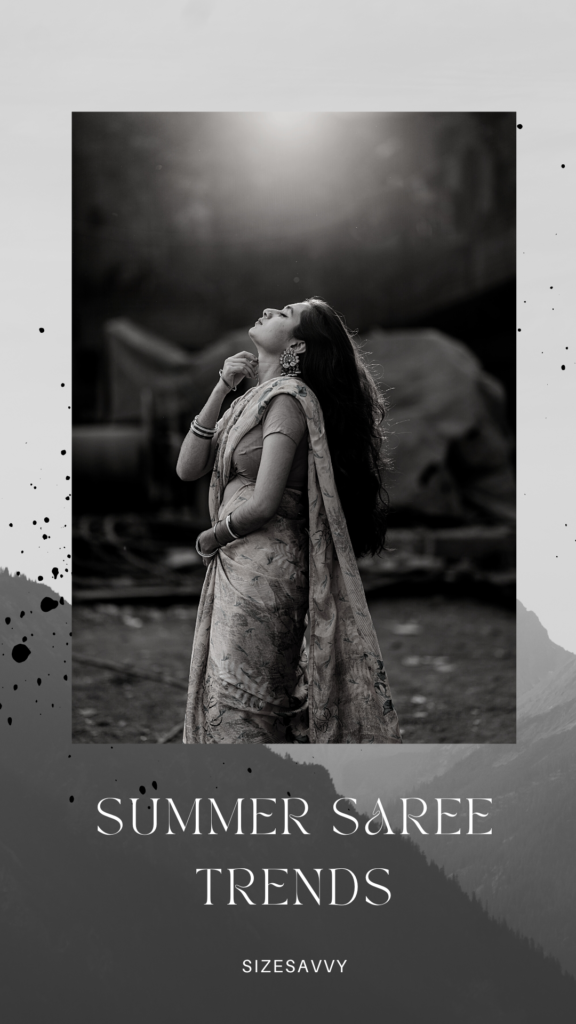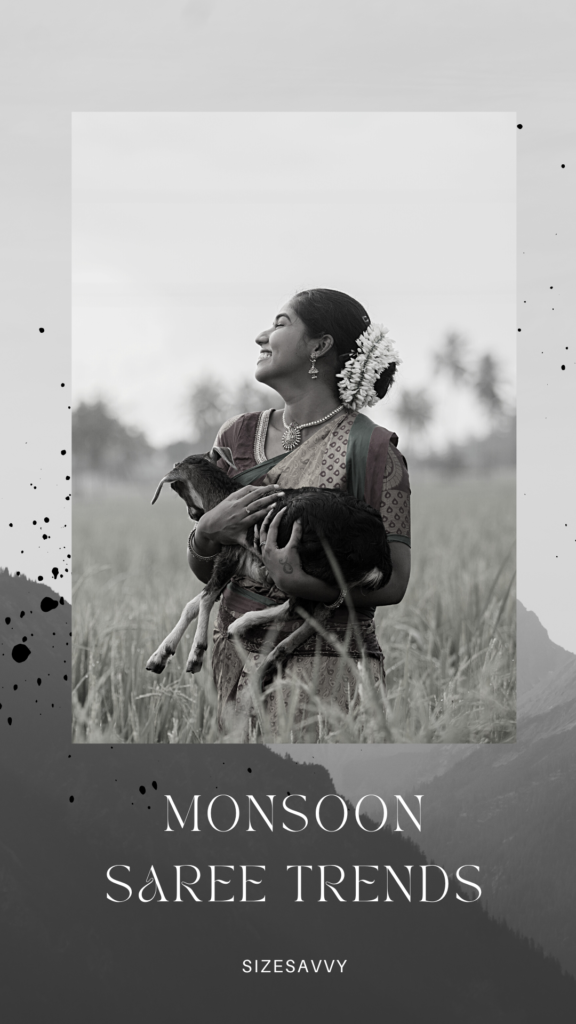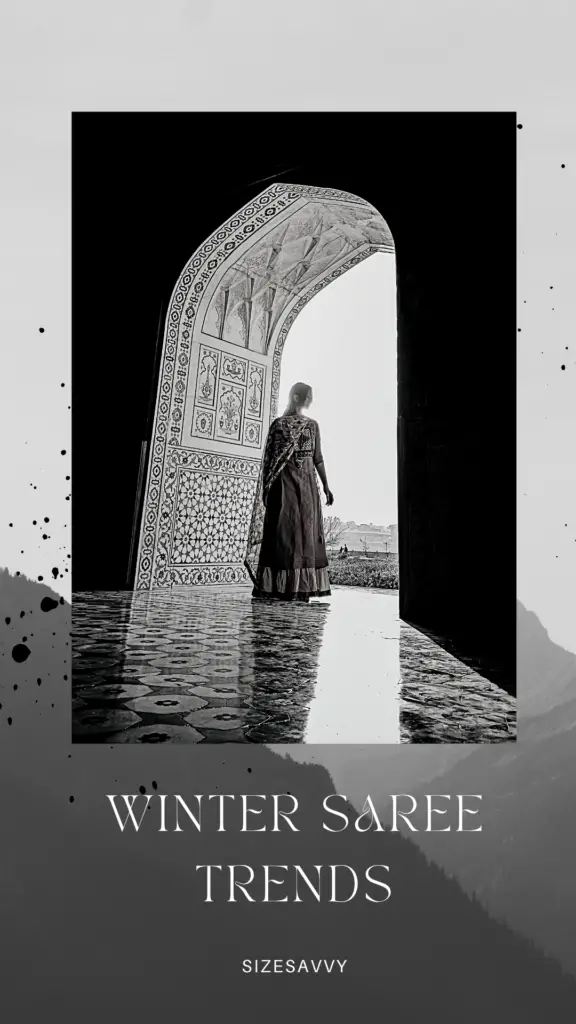Saree Trends for Different Seasons! When it comes to sarees, staying updated with the latest fashion trends can help you make a stylish statement. As the seasons change, so do the preferences for saree designs, fabrics, and colors.
In this blog, we will explore the saree trends for different seasons, allowing you to embrace fashionable styles all year round. before making any seasonal saree pick go through the Types of Saree Material & How To Choose One?
Note: Always Know Your Saree Size. & choose the Branded blouse and Branded Saree option for a great Saree outfit.
Saree Trends for Different Seasons
| Saree Season | Saree Fabric | Saree Colors | Saree Designs |
|---|---|---|---|
| Spring | Chiffon, Georgette, Silk Blends | Pastel shades | Floral prints, delicate embroidery, subtle embellishments |
| Summer | Cotton, Linen, Organza | Cool tones | Geometric patterns, block prints, stripes |
| Monsoon | Synthetic blends, Polyester | Playful colors | Bold prints, abstract motifs, waterproof materials |
| Autumn | Silk, Velvet, Brocade | Earthy tones | Intricate embroideries, traditional motifs, paisley patterns |
| Winter | Wool, Silk, Heavy Silk Blends | Deep tones | Heavy embellishments, zardozi work, jacquard patterns |
Spring Saree

During the refreshing spring season, opt for light and breathable fabrics like chiffon, georgette, or silk blends. Pastel shades such as baby pink, mint green, and lavender are popular choices for a soft and feminine look.
Embrace floral prints, delicate embroidery, and subtle embellishments to capture the essence of the season.
Summer Saree

As the temperatures rise, it’s important to choose sarees made from lightweight and airy fabrics. Cotton, linen, and organza are excellent choices for the summer season.
Cool and soothing colors like sky blue, lemon yellow, and mint green are perfect for beating the heat. Embrace simple and minimalistic designs with geometric patterns, block prints, or stripes for a breezy summer vibe.
Monsoon Saree

The monsoon season calls for sarees that can withstand rainy days. Opt for fabrics that dry quickly and repel water, such as synthetic blends or polyester. Playful colors like bright orange, turquoise, and coral add vibrancy to your rainy-day look.
Bold prints, abstract motifs, and waterproof materials like nylon are suitable choices to stay stylish and protected during the monsoons.
Autumn Saree

Autumn brings a sense of warmth and richness, and your saree choices should reflect that. Embrace rich and textured fabrics like silk, velvet, or brocade. Earthy tones like rust, mustard yellow, and olive green are popular choices during this season. Intricate embroideries, traditional motifs, and paisley patterns create a warm and cozy autumn look.
Winter Saree

As the temperature drops, it’s time to bring out the heavy and luxurious sarees. Choose warm and insulating fabrics like wool, silk, or heavy silk blends. Deep and jewel tones such as royal blue, emerald green, and burgundy add elegance to your winter wardrobe. Heavy embellishments, intricate zardozi work, and intricate jacquard patterns are perfect for winter festivities.
Conclusion: By keeping up with the saree trends for different seasons, you can effortlessly stay fashionable all year round. Embrace the appropriate fabrics, colors, and designs to complement the changing weather and create stunning looks.
Whether it’s the refreshing spring, the scorching summer, the rainy monsoon, the cozy autumn, or the chilly winter, there’s a saree trend to suit every occasion. So, go ahead and update your saree collection with the latest styles, and embrace fashionable elegance throughout the year. Also, check for How to Wear a Saree for Different Occasions for more.
FAQs on Saree Trends
Can I wear a silk saree during the summer season?
While silk sarees are generally considered heavy, you can opt for lighter silk blends that are suitable for the summer season. Look for silk sarees with breathable textures and minimalistic designs to stay comfortable in the heat.
Are pastel shades only suitable for spring sarees?
Pastel shades are commonly associated with spring, but they can also be worn during other seasons. It’s all about how you style and accessorize the saree. In other seasons, you can pair pastel sarees with contrasting or bold-colored blouses and statement jewelry to create a unique look.
Can I wear cotton sarees during the winter season?
Cotton sarees are more suitable for warmer seasons, but you can still wear them during winter by layering them appropriately. Consider wearing a warm blouse, adding a shawl or stole, or draping a pashmina scarf over your cotton saree to keep yourself cozy.
What kinds of prints are popular for monsoon sarees?
In the monsoon season, opt for prints that are less likely to get affected by water or stains. Geometric prints, abstract motifs, and nature-inspired designs work well during this season. These prints not only add visual interest but also help conceal any potential marks caused by raindrops.
Can I wear heavily embellished sarees during the summer season?
Heavily embellished sarees with intricate work are better suited for festive occasions or cooler seasons. During summer, it’s advisable to choose sarees with minimal embellishments or opt for lightweight fabrics with subtle embroidery to avoid feeling weighed down.
Are earthy tones suitable for all skin tones during the autumn season?
Earthy tones like rust, mustard yellow, and olive green can complement various skin tones during autumn. However, the specific shade within the earthy color palette may vary depending on individual undertones. Experiment with different shades to find the ones that enhance your natural complexion.
Can I mix and match saree trends from different seasons?
Absolutely! Fashion is all about personal style and experimentation. Feel free to mix and match saree trends from different seasons to create unique and innovative looks. Adapt the colors, fabrics, and designs to suit your preferences and the occasion.
















I appreciate the effort and time you’ve spent in putting together this information. Thank you for sharing this with us.